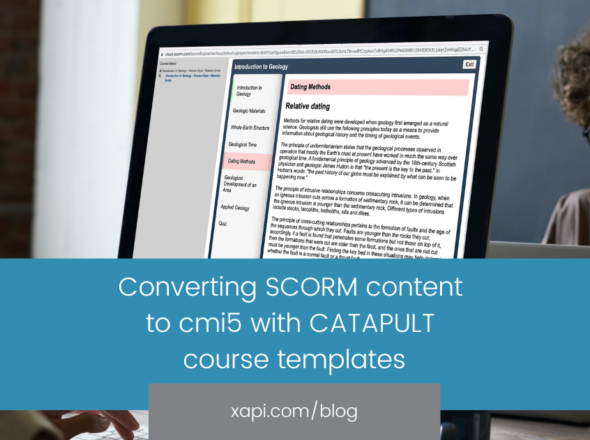While xAPI provides newer, more modern data tracking, it doesn’t specify launching content in an LMS. cmi5, an xAPI Profile, solves the xAPI + LMS launch use case, but adoption rates have been slow because there were no tools or resources available to test conformance to the specification. In a few short weeks, that will all change. cmi5 CATAPULT will launch and introduce new conformance testing tools, example course templates and resources to help accelerate cmi5 adoption rates. Already excited to see the tools? Watch our free webinar with the Advanced Distributed Learning (ADL) Initiative and read on for a sneak peek at what’s to come.
About the cmi5 Content Test Suite (CTS)
The CTS has a web-based user interface and may be locally installed or accessed and deployed from a hosted version provided by ADL for easier content testing. From the CTS, you can upload cmi5 course packages, launch AUs (Assignable Units) as part of test sessions, view and download test results, and perform other basic course and test management tasks to ensure the content is cmi5 conformant.
After importing a course, content professionals will be able to see if the learning activity passed the test suite. If the learning activity didn’t meet one or more of the cmi5 requirements, the tester can view which requirements failed along with that specific part of the specification.
Migrating content with example course templates
To help with the migration of existing legacy SCORM content, six example course templates were created to serve as guides for creating cmi5 courses. Content professionals should focus on the technical components of cmi5 and not on the course content or design. There are four traditional framed courses and two responsive courses that perform better in mobile environments.
Here is an overview of the templates:
Simple Single AU
Demonstrates the most basic content package and includes both framed and responsive examples. The course structure contains only a single AU), which are the launchable pieces of content within the course structure. This course also features bookmarking and video tracking behaviors.
“masteryScore”
The “masteryScore” is an optional mechanism to control the course’s behavior relative to determining passed or failed status. This example incorporates a simple quiz that requires a certain score to be achieved to receive a passing result. This template also features interaction behaviors and includes both framed and responsive examples.
Multiple Top-Level AU
This example takes the contents of the “masteryScore” template and spreads them across several AUs, nested at the topmost level of the course structure. The AUs have appropriate moveOn criteria for their execution. The moveOn criteria determines what is required for an AU to be considered “Satisfied”.
Pre/Post Test
Demonstrates a course structure of blocks with each block containing a pre-test, content section and post-test AU. This example also includes a cmi5 Extension, a way to extend the valid tags and attributes allowed inside an XML course structure.
About the cmi5 LMS Test Suite (LTS)
The LTS application is a command line interface (CLI) that leverages the library of test packages to automate the testing of an LMS claiming to have cmi5 capability. The CLI will expose an LMS integration interface that will have to be implemented on a per LMS basis. Note that the cmi5 specification uses the term LMS to describe the system that is “launching” the cmi5 content, but the system may or may not be a traditional Learning Management System.
To help developers or LMS professionals with the testing process, a procedure guide for navigating the testing process manually will also be released. Alternatively, a script can be written to automate the process. If one of the steps of the testing process does not produce the desired results as outlined in the procedure guide, then the developer will know that the LMS is in violation of that part of the cmi5 specification.
Learn about the cmi5 Player Prototype
The open-source cmi5 Player Prototype functions as an authenticated, web-based system that connects to an LRS. The Player Prototype is able to import content from a single list of files and sequences that content dynamically based on the requirements of the cmi5 specification. User documentation and implementation instructions will be available alongside the software in GitHub.
Attend the ADL cmi5 CATAPULT webinar
Ready to see how the tools work and how to use them? Watch Brian Miller and George Vilches from Rustici Software and Andy Johnson from ADL discuss the Accelerating cmi5 Adoption: Exploring the Conformance Test Suites and Tools Webinar.
Have questions about cmi5? We’re happy to help!


